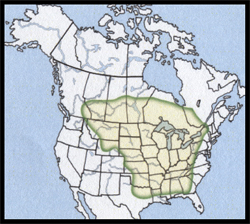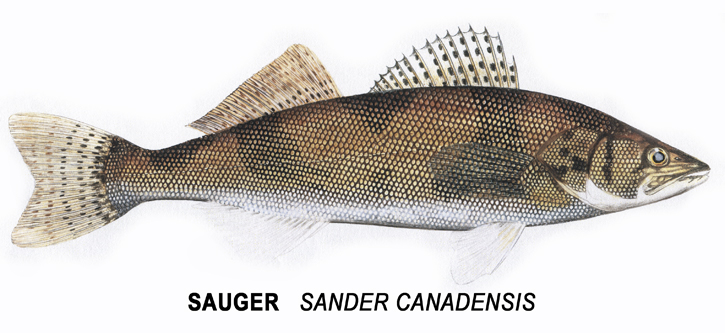Sauger, October 2015, Fish of the Month!
Sauger
Sander canadensis
Local Names:
Gray pike, River pike, Jack, Sand pike, Spotfin pike, Pickering, Horsefish
Average Size:
10 to 15 inches
½ to 1 pound
Distinguishing Field Marks:
(See the illustration.)
-
The body is distinctly elongated, nearly round in cross-section.
-
There are indistinct dark patches on the sides.
-
The head is elongated with a mouth of moderate size which has an upper jaw that extends to the mid-point of the eye.
The eye is large.
Both the gill covers and cheeks are scaled.
There is a distinct space between the first and second dorsal fins.
The caudal peduncle is long and slender, cylindrical in cross-section.
North American Range:
Map to the right shows approximate range in North America.
Diet:
Very young Sauger feed on zooplankton then graduate to small immature aquatic insects, then to larger aquatic insects and other invertebrates, and finally, as adults, to crayfish and small fish.
Biology:
The Sauger spawns in late spring and early summer. The males are first to seek spawning grounds on shoals in lakes or large rivers, followed by the females. Sauger prefer to breed in 2 to 20 feet of water. Spawning behavior consists of a single large female being accompanied by several smaller males which press their snouts close to her body. The eggs are shed and fertilized with the fish remaining in this position. The fertilized eggs are semi-buoyant and non-adhesive, simply slowly sinking to the bottom where they lodge in cracks in the rubble or gravel. Incubation takes about 25 to 30 days and is followed by another period of a week to 10 days in which the fry are dormant while they absorb the yolk sac. The average number of eggs produced is between 8,000 and 80,000.
Fly Fishing for Sauger:
Sauger grow quite slowly in the northern part of their range and more rapidly to the south. They only seldom reach lengths of 20 inches and, when caught by anglers, are often mistaken for small Walleye, with which they share much of their range.
Adult Sauger are commonly found in turbid shallow lakes and rivers. Their highly light-sensitive eyes, like those of the Walleye, are designed for night feeding, but the Sauger's preference for not-so-clear water allows them to inhabit all levels of the water column and extend their feeding window of opportunity.
Those of us who pay attention to this sort of information are well aware that we fly-rodders have vastly expanded our list of possible fish species for some 50 or so years. We're now throwing flies at school tuna, billfish, sharks, carp, and a host of previously ignored fresh and saltwater fish. These last two entries into our Hook & Hackle Fish of the Month column, Sauger and Walleye, are among those.
Because you'll be fishing medium to large streamers with sink-tip lines for both Walleye and Sauger, you'll want to equip yourself with 6 , 7, or even 8 weight outfits, depending on the type of water you'll be fishing. For fly tiers, these two species open plenty of experimental fly color, material, and design opportunities. Our standard American fly pattern reference books don't yet contain chapters on Sauger flies…….However, the global internet does supply us with a readily available compendium of information posted about fly fishing and flies for both these members of the Perch family. We advocate catch and live release for all our North American game fish species, however, Yellow perch, Sauger, and Walleye are some of our very best tasting fresh water fish. Obey all state and local fishing regulations for all species, including daily bag limits, and, staying within those limits, by all means take some Sauger home for dinner.
Significance to Humans:
The Sauger has been and continues to be the basis for an important commercial fishery, especially in Canada. The flesh is firm and of very good flavor, considered by some to be superior to that of Walleye.
Status:
Maintaining.







